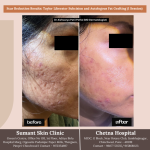What is Paronychia?
Paronychia is an infection of the soft tissue that surrounds the nail, typically affecting the cuticle or the sides of the nail. It can occur in both fingernails and toenails and may affect people of all ages.
There are two types of paronychia:
Acute Paronychia: This comes on suddenly and is usually caused by bacteria (commonly Staphylococcus aureus).
Chronic Paronychia: This develops over time, often due to repeated exposure to moisture or irritants, and may involve fungal infections like Candida.
What Causes Paronychia?
Paronychia usually develops when germs enter the skin through a break or injury. Common causes include:
Nail biting or picking at the skin around the nail
Damage from aggressive manicuring or artificial nails
Pushing back or cutting cuticles
Frequent exposure to water, detergents, or chemicals
Ingrown nails
These small injuries or irritations create an entry point for bacteria or fungi, leading to infection.
Symptoms to Watch For
The symptoms of paronychia may vary depending on whether it is acute or chronic.
Acute Paronychia Symptoms:
Sudden redness and swelling around the nail
Pain and tenderness
Warmth in the affected area
Formation of pus (abscess)
Chronic Paronychia Symptoms:
Gradual onset of swelling and redness
Thickening or discoloration of the nail
Persistent discomfort
Nail deformities over time
Treatment Options
In mild cases, paronychia can be treated at home with warm soaks and over-the-counter antibiotic or antifungal creams. However, if the infection does not improve, becomes very painful, or produces pus, you should seek medical attention.
When is Surgery Needed?
If pus has formed, minor surgical drainage may be necessary. This simple outpatient procedure involves:
Making a small incision to drain the pus
Cleaning the infected area
Applying a sterile dressing
The procedure offers immediate relief and helps prevent the spread of infection. It is usually quick and performed under local anesthesia.
How to Prevent Paronychia
Avoid biting your nails or picking at the skin
Don’t cut or push back cuticles aggressively
Wear gloves when handling water, chemicals, or harsh cleaners
Keep your nails trimmed and clean
Moisturize your hands and nails regularly
When to See a Doctor
You should seek medical help if:
Pain or swelling worsens
You notice pus or yellow discharge
The infection doesn’t improve in a few days
You have repeated episodes of paronychia
Paronychia may seem minor at first, but early treatment is key. If you’re experiencing persistent nail pain, swelling, or discharge, don’t wait. Proper diagnosis and timely intervention, including minor surgical procedures when needed, can restore your nail health and prevent serious complications.
For Consultation Contact us on 8390861787 / 9158681123
Website – www.chetnahospital.co.in
Address – Chetna Hospital, Sambhajinagar, MIDC, G Block, Near Rotary Club, Chinchwad 411019
.
.
.
#pune#pcmc#chinchwad#hospital#medical#medicalservices#health#healthcare#surgery#generalsurgery#medicalprocedure#generalsurgeon#generalsurgeoninchinchwad













